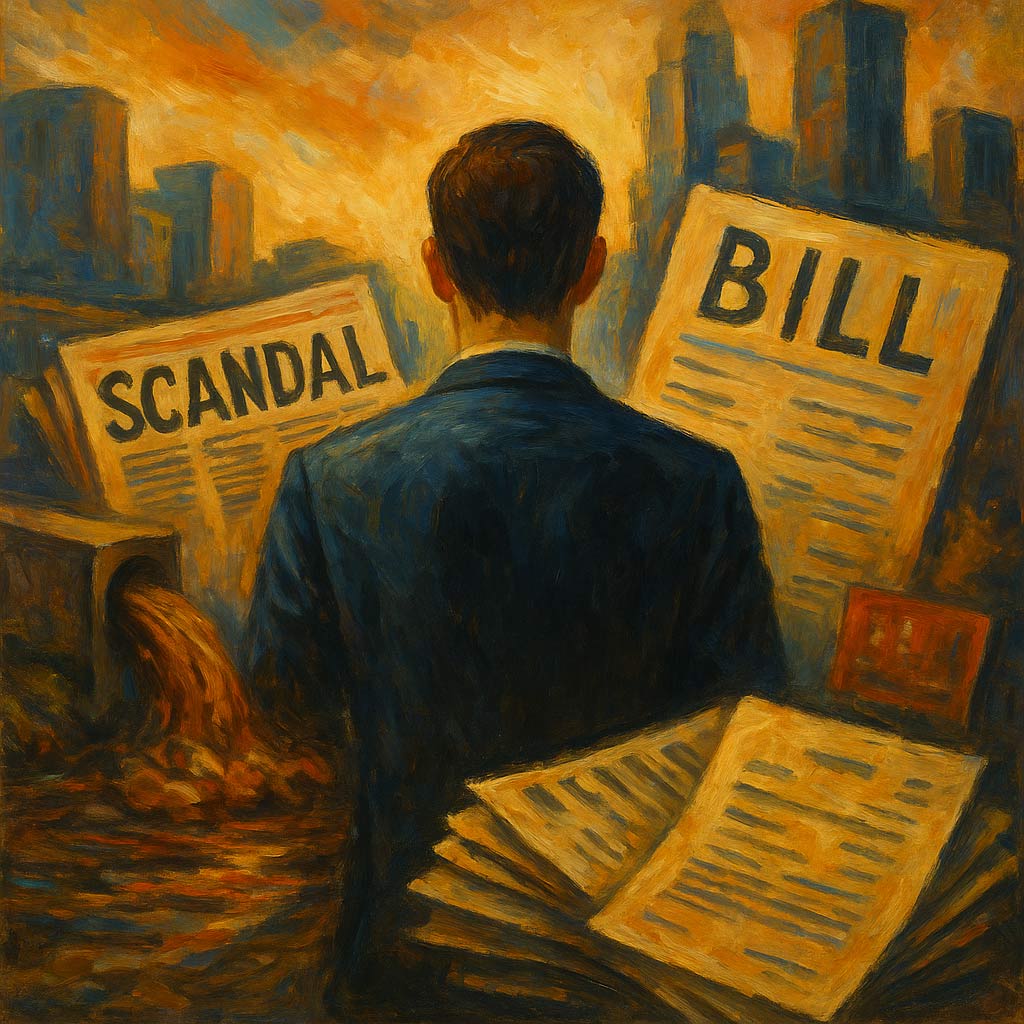The Crisis of Public Confidence
Across the UK, confidence in our core public institutions is crumbling and the cracks are no longer hidden beneath bureaucracy. They’re overflowing into rivers, stitched into bank letters, written in the fine print of utility bills, and splashed across newspaper headlines. From the ongoing sewage discharges linked to Thames Water, to the grotesque miscarriages of justice exposed by the Post Office Horizon scandal, and the mounting cost of energy and finance scandals like PPI and car loans, we are witnessing not isolated failures but systemic erosion.
These failures share a common denominator: they occurred under the gaze or in the blind spots of regulators tasked with protecting the public interest. Institutions like OFWAT, the Financial Conduct Authority (FCA), and Ofgem were built on the promise of public oversight. Yet too often, they appear late to act, slow to respond, and constrained by politics, legal ambiguity, or a lack of technological capacity. The result is a public that increasingly feels overcharged, underserved, and unheard.
At a time when technology governs everything from how we pay our bills to how we communicate, the question must now be asked: what would a regulator look like if it was designed not for corporate appeasement, but for public protection in the digital age?
The Problem Isn’t Just Policy — It’s Systemic Design Failure
What we’re facing in the UK isn’t merely a failure of regulation, it’s a failure of regulatory design. Most existing watchdogs were created in a time when oversight meant paper trails, quarterly reports, and occasional whistleblowers. These institutions emerged in an analogue world where data was slow, transactions were local, and public trust was largely implicit. But that world has been replaced — not gradually, but abruptly — by a digital one where real-time complexity is the norm.
Today’s utilities and financial services operate in vast algorithmic environments. Pricing models shift dynamically. Data is harvested, monetised, and traded in milliseconds. Critical infrastructure — from billing systems to supply chains — is automated and scaled through code. Corporate performance is optimised by predictive analytics, not managerial intuition. And yet, regulators are still operating on frameworks and tools designed for a pre-digital economy.
This creates a dangerous asymmetry. When regulation lags behind technological acceleration, oversight becomes ceremonial, unable to anticipate harm, detect breaches in real time, or enforce consequences at scale. The rule of law itself begins to fray when it cannot keep pace with the systems it’s meant to govern. It’s not simply that injustice slips through the cracks — it’s that the architecture ensures those cracks remain.
What’s most troubling is that this failure disproportionately affects the public. Clean water, fair energy prices, transparent banking practices — these are not luxuries; they are civic rights. Yet they are routinely compromised, not just by corporate negligence, but by regulators who cannot see deeply enough, act quickly enough, or intervene strongly enough.
In this context, public well-being is no longer merely neglected, it’s structurally deprioritised.
The Ethics of Infrastructure
The late sociologist Ulrich Beck famously argued that contemporary societies are shaped less by ideology than by the management — or mismanagement — of risk. In today’s hyperconnected world, risk is no longer abstract. It is systemic, omnipresent, and deeply uneven. Whether it’s the fragility of financial markets, the erosion of public utilities, or the accelerating collapse of ecosystems, the burdens of unmanaged risk fall most heavily on those least equipped to bear them: the working class, the digitally marginalised, the elderly, and those living at the edge of socio-economic precarity.
In this climate, regulation can no longer be treated as a procedural safeguard — a checkbox of compliance. It must evolve into a form of ethical infrastructure: a framework built not just to mitigate failure but to enshrine justice, resilience, and public dignity into the very code of our civic systems.
This requires more than good intentions. It demands a fundamental rethinking of how technologies — particularly those underpinning our utilities and financial systems — are designed, deployed, and governed. Transparency, inclusion, accountability, and truth must not be rhetorical aspirations; they must be hard coded into the architecture itself. They must be programmable ethics — operationalised through smart contracts, decentralised ledgers, and auditability by default, not exception.
Because when institutions falter, it is not the abstract concept of the state that suffers — it is the human beings whose lives depend on its protections. And in an age defined by cascading crises, the legitimacy of our democracy may hinge not on how quickly we adapt policy, but on how boldly we reimagine the infrastructures of fairness.
Reimagining the Regulator: A New Technological Mandate
Envision a regulator that doesn’t wait for scandals to surface or internal reports to leak. Instead, it acts in real time — constantly, quietly, and decisively. Picture a system where sewage overflows aren’t hidden until a journalist breaks the story but automatically flagged by IoT sensors and logged onto a public blockchain before the damage spirals. A civic infrastructure where every complaint, service failure, procurement contract, and executive promise is time-stamped, tamper-proof, and permanently visible — not to a hidden boardroom, but to the public it serves.
This is not a speculative fantasy. It is already beginning to unfold.
In Estonia, blockchain underpins key state systems — from medical records to tax administration — offering an unprecedented degree of transparency and integrity in public governance. In Seoul, city planners are deploying distributed ledger technologies to monitor public transport operations, tracking where efficiency breaks down and where resources are most needed. These are living case studies of what can be done when ethical infrastructure is not an afterthought, but a principle.
But if Web3 is the engine of this future — decentralised, verifiable, incorruptible — then Web2 remains the interface. For all its platform capitalism flaws, Web2 still connects with the daily user: through dashboards, feedback loops, and accessible apps. It’s where people talk, file complaints, monitor bills, and check on public services. If the trustless mechanics of Web3 are to succeed, they must be translated into user experiences that are intuitive and human. Civic legitimacy is earned not just through incorruptibility but through usability.
Yet the real breakthrough will not come from the tech stack alone. It must emerge from a re-engineered regulatory mandate: one that anchors technological design in legal principle and moral clarity. A regulator must not serve as a steward of industry interests or a reactive arbiter of last resort. It must be legally independent, structurally unfundable by those it oversees, and constitutionally aligned to the public good.
In this vision, blockchain is not a buzzword. It is a civic safeguard. Web2 is not a distraction — it’s a bridge. And regulation, long cast as dry or slow-moving, becomes something altogether different: dynamic, participatory, and above all, just.
Independence Must Be More Than Symbolic
Too many regulators rely on state funding that fluctuates with political cycles or are financed — directly or indirectly — by the industries they regulate. This creates a dangerous conflict of interest, often referred to as “regulatory capture,” where oversight becomes passive and enforcement, symbolic.
To break this cycle, we must build a new funding model: one that guarantees operational independence, is transparent by design, and cannot be quietly dismantled by political pressure.
Blockchain-based crypto architecture could help. A regulator could be partially funded by a public utility token — one that reflects the value of oversight itself. This token would not be traded like a speculative asset but issued through clear, capped rules, and linked to regulatory enforcement actions, fines, and service-level contributions from providers. Crucially, this system would be publicly visible, audited in real time, and overseen by civic-led governance bodies. It would enable the regulator to act with strength, clarity, and moral force — accountable to the people, not beholden to profit.
A Sector-by-Sector Transformation
This new regulatory architecture isn’t just theoretical — its impact could be profound across every major public service. In the water sector, for example, pollution levels could be monitored in real time by sensors linked to smart contracts. If contamination thresholds are breached, the system could automatically trigger fines or freeze shareholder dividends — no waiting, no buried reports, no delayed accountability.
In the financial sector, protections could be built directly into the digital code of lending platforms. The kinds of predatory schemes that led to the PPI and car loan scandals wouldn’t just be regulated — they’d be rendered structurally impossible. Borrowing terms, interest rates, and repayment schedules could be made transparent, immutable, and fair by design.
Energy markets, often plagued by opaque pricing and subsidy confusion, could become models of transparency. Public ledgers could verify billing accuracy, track energy usage, and ensure that government subsidies reach the intended recipients — not lost in administrative inefficiency or private profiteering.
Even in the realm of postal services, where the Horizon IT scandal ruined hundreds of lives, blockchain infrastructure could provide decentralised audit trails — ensuring evidence can never be altered or erased behind closed doors. The manipulation of data would no longer be a matter of managerial discretion but a technical impossibility.
Across each sector, the principle remains the same: treat data not as a corporate asset, but as a public truth. In doing so, we shift the balance of power — away from opacity and profit, and toward transparency, justice, and the well-being of the people these systems are meant to serve.
A Civic Technology for the Public Good
As philosopher Hannah Arendt once wrote, “power arises only where people act together.” A new regulator cannot be a black box in Whitehall or a token department starved of funding. It must be public-facing, participatory, and infused with legitimacy from the ground up.
This requires a cultural shift as much as a technological one — recognising that the health of a democracy depends not just on elections or laws, but on everyday mechanisms of trust, memory, and recourse.
Web3, if wielded with care, can offer digital memory that is immune to deletion or political distortion. Smart contracts can provide enforceable promises, not press releases. Zero-knowledge cryptography can enable targeted support for vulnerable consumers without compromising dignity or privacy.
But the regulator of the future must do more than adopt these tools. It must be designed around them — with clear rules, human rights embedded in code, and the legal teeth to act in the public interest, even when doing so is politically uncomfortable.
Conclusion: Building a Future That Doesn’t Forget
The UK does not suffer from a lack of intelligence or moral outrage. It suffers from institutional inertia — a reluctance to question systems that have long since lost public trust. But we now have the chance to do more than patch a broken system. We have the chance to rebuild it — not from ideology, but from ethical principles, digital integrity, and civic strength.
The regulator of tomorrow is not just a watchdog. It is a civic engineer. It is a platform of protection, a memory system for justice, and an interface between law, people, and power. And if we build it right, it may just help us remember who public services are really for.
By Pritish Beesooa, Head of Blockchain and Web3 Development
At Nocturnal Cloud, we are committed to shaping the next generation of Web2 and Web3 technologies through a guiding principle we call ethical technology — digital systems designed to serve the public good, protect the consumer, and strengthen the foundations of a just society.
Our mission is rooted in collaboration. We believe that only by working across sectors — with technologists, policymakers, communities, and concerned citizens — can we build the infrastructure that tomorrow demands. From transparent digital governance to decentralised regulatory frameworks, we’re already laying the groundwork through initiatives like the Regulator of Tomorrow.
If you share our vision for a more equitable, transparent, and accountable technological future, we invite you to join us. Let’s build ethical technology — not as a slogan, but as a shared responsibility.
Reach out. Collaborate. Contribute. The future is still programmable.











